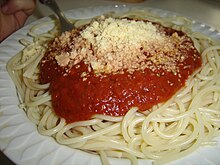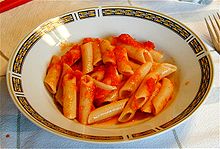Tomato sauce: Difference between revisions
m Reverting possible vandalism by 74.142.203.145 to version by 72.49.165.66. False positive? Report it. Thanks, ClueBot. (650483) (Bot) |
No edit summary Tag: Incorrectly formatted external link or image |
||
| Line 48: | Line 48: | ||
=== Tomato gravy === |
=== Tomato gravy === |
||
''Tomato gravy'', which is distinct from the term as used by northeastern Italian Americans when referring to tomato sauce, is a sauce common in most rural areas of the United States, particularly where tomatoes were a [[staple food]]. Tomato gravy is prepared in a method similar to [[gravy#Types of gravy|white gravy]]. The cooked tomatoes, some fat (usually cured [[lard|pork fat]]) and flour are cooked together until thick, and [[seasoning|seasoned]] with salt and pepper. Typically, tomato gravy is served over [[egg (food)|eggs]], [[toast]] and [[biscuit]]s. |
''Tomato gravy'', which is distinct from the term as used by northeastern Italian Americans when referring to tomato sauce, is a sauce common in most rural areas of the United States, particularly where tomatoes were a [[staple food]]. Tomato gravy is prepared in a method similar to [[gravy#Types of gravy|white gravy]]. The cooked tomatoes, some fat (usually cured [[lard|pork fat]]) and flour are cooked together until thick, and [[seasoning|seasoned]] with salt and pepper. Typically, tomato gravy is served over [[egg (food)|eggs]], [[toast]] and [[biscuit]]s. |
||
[[File:http://commons.wikimedia.org/wiki/Image:Ethan_Hawke_-_2009_Venice_Film_Festival.jpg]] |
|||
==Indian== |
==Indian== |
||
Revision as of 23:56, 25 August 2010
This article needs additional citations for verification. (April 2009) |
- This article is about the sauces often used with pasta or pizza. In some countries, "tomato sauce" means ketchup.

A tomato sauce is any of a very large number of sauces made primarily from tomatoes, usually to be served as part of a dish (rather than as a condiment). Tomato sauces are common for meat and vegetables, but they are perhaps best known as sauces for pasta dishes.
Tomatoes have a rich flavour, low liquid content, very soft flesh which breaks down easily, and the right composition to thicken into a sauce when they are cooked (without the need of thickeners like roux). All of these qualities make them ideal for simple and appealing sauces. The simplest tomato sauces consist just of chopped tomato flesh (with the skins and seeds optionally removed), cooked in a little olive oil and simmered until it loses its raw flavour, and seasoned with salt.
Water (or another, more flavourful liquid such as stock or wine) is often added to keep it from drying out too much. Onion and garlic are almost always sweated or sautéed at the beginning before the tomato is added. Other seasonings typically include basil, oregano, parsley, and possibly some spicy red pepper or black pepper. Ground or chopped meat is also common.
In countries such as Australia, New Zealand and in Southern Africa, the term 'tomato sauce' is used to describe a condiment similar to that known in the USA as 'ketchup'.[1] In Britain, both terms are used for the condiment.

French
The sauce tomate of classical French cooking, as codified by Auguste Escoffier, consists of salt belly of pork, onions, bay leaves, thyme, tomato purée or fresh tomatoes, roux, garlic, salt, sugar, and pepper. Many times butter and flour will be listed in the ingredients, but those are only used to make the roux (thickening agent). Roux is made of equal parts by weight of flour and butter. Any extra flour or butter that is called for in the recipe is typically an error. [2]
Australian
The most common use of the term tomato sauce in Australia is to describe a commercially produced condiment similar to American ketchup, which is used as a topping on foods such as meat pies and sausages.[3][4] "A pie and sauce" is a traditional lunch for many working people, and is available from most takeaway food shops and many bakeries. It is probably one of the most common expressions to be translated into rhyming slang, in the form of "a dog's eye and dead horse".[5][6]
Italian

The misconception that the tomato has been central to Italian cuisine since its introduction from the Americas is often repeated. Though the tomato was introduced from the Spanish New World to European botanists in the 16th century, tomato sauce made a surprisingly late entry in Italian cuisine: in Antonio Latini's cookbook Lo scalco alla moderna (Naples, 1692).[7] Latini, not unsurprisingly, was chef to the Spanish viceroy of Naples, and one of his tomato recipes is for sauce alla spagnuola, "in the Spanish style".
Outside Italy, the role of tomato sauce has been quite exaggerated: many people know little of Italian cuisine beyond pasta with tomato sauce. Italian varieties of tomato sauce range from Pasta Puttanesca sauce, seasoned with anchovies, capers, garlic, chilli peppers and black olives, to Bolognese sauce, a predominantly minced or ground meat sauce which normally contains a small-to-moderate amount of tomato.
Mexican
Tomato sauce was an ancient condiment in Aztec food. The first person to write of what may have been a tomato sauce was Bernardino de Sahagún, who made note of a prepared sauce that was offered for sale in the markets of Tenochtitlan (Mexico City today). Then, Spaniards brought the use of tomato to Europe.
Basic Mexican tomato sauces are tomato sauce (salsa de tomate rojo o jitomate) and green tomato sauce (salsa de tomate verde). The tomato sauce is stock for spicy sauces and moles.
United States


In most of the U.S., "tomato sauce" refers to a tomato concentrate with salt, herbs and small amounts of spices and often flavored with meat or seafood. It is sold in bottles and cans. This product is considered incomplete and not normally used as it is. Instead, it is used as a base for almost any food which needs a lot of tomato flavor, including versions of many of the sauces described on this page. Tomato purée and and tomato paste have FDA standards of identity (since 1939) for percentage of tomato solids, and generally do not contain seasonings other than salt; tomato sauce is nonstandardized.[8]
Marinara sauce is an American-Italian term for a simple tomato sauce with herbs—mostly parsley and basil—but, contrary to its name (which is Italian for coastal, seafaring) without anchovies, fish or seafood. In other countries, marinara refers to a seafood and tomato sauce.
Some Italian Americans on the East Coast refer to tomato sauce as "gravy", "tomato gravy", or "Sunday gravy", especially sauces with a large quantity of meat simmered in them, similar to the Italian Neapolitan ragù. "Gravy" is an erroneous English translation from the Italian sugo which means juice, but can also mean sauce (as in sugo per pastasciutta). The expression for "gravy" in Italian is sugo dell'arrosto, which is literally "juice of a roast" and is specifically not tomato sauce.[9]
American supermarkets commonly carry a variety of prepared tomato sauces described as "spaghetti sauce" or "pasta sauce". Common variations include meat sauce, marinara sauce and sauces with mushrooms or sweet red peppers.
Louisiana
A spicy tomato sauce known as sauce piquante is common in Louisiana Cajun cuisine, that can contain any seafood, poultry, or meats such as wild game. It is typically served over white rice. In Louisiana Creole cuisine, there is a tomato sauce known as a Creole sauce. It is similar to Italian tomato sauce, but features more Louisiana flavors derived from the fusion of French and Spanish cooking styles. They both usually contain the traditional holy trinity of diced bell pepper, onion, and celery.
Tomato gravy
Tomato gravy, which is distinct from the term as used by northeastern Italian Americans when referring to tomato sauce, is a sauce common in most rural areas of the United States, particularly where tomatoes were a staple food. Tomato gravy is prepared in a method similar to white gravy. The cooked tomatoes, some fat (usually cured pork fat) and flour are cooked together until thick, and seasoned with salt and pepper. Typically, tomato gravy is served over eggs, toast and biscuits.
File:Http://commons.wikimedia.org/wiki/Image:Ethan Hawke - 2009 Venice Film Festival.jpg
Indian
Indian curry, especially as it has been exported out of India, is recognizable for heavily spiced sauces, often made from a tomato base.
See also
References

- ^ http://journals.worldnomads.com/leah/gallery/13544/384186.aspx
- ^ Auguste Escoffier, The Complete Guide to the Art of Modern Cookery (New York: Wiley, 1979), 9–10.
- ^ http://www.intrepidtravel.com/express-blog/?p=44
- ^ http://www.australianbeers.com/culture/tucker.htm
- ^ http://www.koalanet.com.au/australian-slang.html
- ^ http://www.intrepidtravel.com/express-blog/?p=44
- ^ Elizabeth David, Italian Food (1954, 1999), p 319, and John Dickie, Delizia! The Epic History of the Italians and Their Food, 2008, p. 162.
- ^ http://contadina.com/tips-advice/faq.aspx
- ^ Love, C., Webster's New World Italian Dictionary, Concise Edition (Macmillan 1991) ISBN 0-13-953639-6
External links
- The Cook's Decameron: A Study In Taste, Containing Over Two Hundred Recipes For Italian Dishes from Project Gutenberg. This is from a very old source, and reflects the cooking at the turn of the 20th century.
- Free Culinary School Podcast Episode 11 A podcast episode that discusses how to make the classical French Mother Sauce version of "Sauce Tomat," which modern versions of tomato sauce are derived from.

